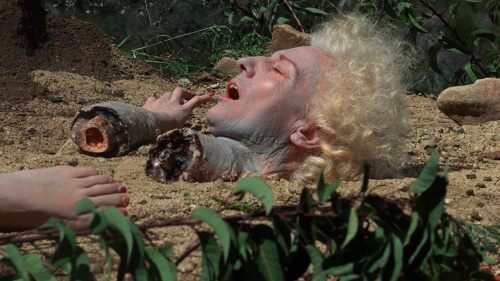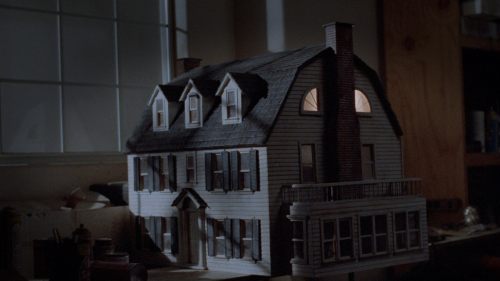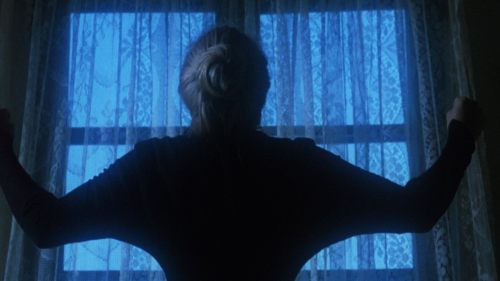Exploitation TV: Volume Five
For cinephiles, the definition of home video label Vinegar Syndrome’s name is something like a secret handshake. The disease it references consumes celluloid. When film stock starts to degrade, it releases acetic acid, the key ingredient in (you guessed it) vinegar. This phenomenon became a plague during the 80s, chewing up prints of pictures improperly stored in hot, humid conditions. In many cases, where reels of smaller films were scarce due to budgetary restrictions, one bad case of vinegar syndrome could rob the planet of an artist’s work.
According to a ‘12 study conducted by the Library of Congress, only 14% of nearly 11,000 movies made between 1912 and 1930 exist in their original format. Around 70% were lost completely. Coming in at a close second in terms of casualties is the Exploitation Era. This really shouldn’t come as a surprise to anyone, as many of the weirder, more obscure movies made during these decades of disrepute are pictures we’ve probably never heard of in the first place. Thankfully, the Bridgeport, Connecticut boys at VS own a private archive, from which they’ve been pulling and scanning prints of overlooked horror, exploitation and smut cinema from all eras. To make it easier on all us degenerates, they’ve even established a streaming service, where you can log in and watch all the back alley oddities they’ve been uncovering and preserving, so that true vinegar syndrome doesn’t rob us of any more great trash art.
After a brief hiatus, we’re back. This week, Exploitation TV covers three bizarre early 70s thrillers…

Sometimes Aunt Martha Does Dreadful Things [1971] (d. & w. Thomas Casey)
There were numerous rip offs that emerged in the wake of Alfred Hitchcock’s Psycho (’60), but none quite like Sometimes Aunt Martha Does Dreadful Things, which presents its version of Norman Bates as two men, in love, one of which is always wearing women's clothing, while the other is a sexually frustrated hippie, his murderous rage lighting up whenever a beach bunny turns him on. This sunny piece of Florida exploitation from one-and-done weirdo Thomas Casey owns its queer bent with pride, turning the melodramatic home-life of Paul (Abe Zwick) and Stanley (Wayne Crawford) into the main thrust of his ruddy motion picture. We spend just as much time listening to the two demented lovers debate how they’re going to divide up their domestic duties, as we do watching the "lady" of the house negotiate with a wayward junkie who’s looking to blackmail his way into having his own room in their modestly impressive suburban home.
Perhaps the most fascinating aspect of Aunt Martha is it’s alternatingly progressive (for the time, at least) and aggressive attitudes toward the cultures which helped birth it. Totally accepting of its queer protagonists, Casey presents this central, psychotic relationship with genuine affection. One of the most mind-blowing aspects of the writer/director's only movie is the fact that several neighbors and strangers encounter Paul (dressed up in his “Martha” garb and utilizing an effeminate voice) and are totally fine with his lifestyle (though, to be fair, the film plays it as if he passes for a woman without question, which he most certainly doesn’t). At the same time, their victims are chosen from a gaggle of local Flower Children, who Stanley smokes pot with and lures back to be killed. Aunt Martha is a movie at war with itself, and knows it, staging the climax in an old movie studio, where Paul and Stanley engage in a deadly lovers’ spat, the stage lights extinguished, just like their dying affection for one another. It’s all an act, while white hot hate boils beneath a placid, “just like you” surface.

Night of the Strangler [1972] (d. Joy N. Houck Jr., w. J.J. Milane, Robert A. Weaver & Jeffrey Newton)
Co-starring The Monkees' Micky Dolenz, and featuring absolutely zero suffocations (though there are a few snipings, as well as a death by poisonous snake), Night of the Strangler is an outlandish slice of regional hot house exploitation. The picture's Southern baked attitudes toward race and class clash with the ostensibly forward thinking views it owns regarding a black priest (Chuck Patterson) trying to keep his Louisiana Parish in order while a madman picks off its community members one by one. While not entirely coherent, Joy Houck's tackling systems of oppression, simultaneously crafting a sweltering potboiler that uses 'Nam era social restlessness as an excuse to have this New Orleans microcosm stand in for the whole of the United States' sociological woes.
James Ralston (Thunder Run) leads a cast of lumpy locals, who tear into the script as if it were a Tennessee Williams dramatic explosion, the stealthy killings (which are pulled off by contracted vets who've returned home from the war) playing second fiddle to interracial teeth gnashing. Those who're easily offended by slurs may want to steer clear, as Night of the Strangler is shameless in its attempts to depict how these hillbillies parading as socialites communicate with one another. Houck's work is yet another example of why the crude frankness of exploitation was more truthful than any studio film could hope to be, immersing us in the ugliness of society with the hopes of making its point in shocking fashion. The final reel is a stunner, pulling a twist ending from its filmic ass that will leave you grinning ear to ear.

Sugar Cookies [1973] (d. Theodore Gershuny, w. Theodore Gershuny & Lloyd Kaufman)
Co-written by Troma honcho Lloyd Kaufman, produced by Oliver Stone, and directed by the man who gave us Z-Grade asylum horror, Silent Night, Bloody Night ('73), Sugar Cookies is a movie about cults that never includes any semblance of robes or rituals. Instead, its about a smut producer (George Shannon), who offs his 42nd Street starlet lover (Lynn Lowry), causing her lesbian girlfriend (Mary Woronov) to investigate the kinky "sex game" that led to her death. The porn (exuse me, "art film") industry that these beautiful, sleazy folks call home becomes an inescapable prison, where beauty and obsession are its only rites of passage. Theodore Gershuny paints it all in a series of ornately decorated, lushly shot tableaus that are far more gorgeous than this sort of scummy pulp deserves.
There's an element of "softcore Vertigo" injected into the narrative, as Lowry plays both the slain actress, and the new girl who's recruited to help Woronov's grieving beauty hunt the arrogant, deadly moneyman down. Watching these two scamper around this manufactured XXX playground is a delight for cult film fans, who fell in love with Mary via her work with Paul Bartel (Death Race 2000 ['75], Eating Raoul ['82]) and Lowry in David Cronenberg's Canadian horror (Shivers ['75]). As a thriller, Sugar Cookies isn't entirely successful (as it never actually thrills), but the elaborate labyrinth of desperate fuck dolls borders on being hypnotically salacious. This is Daytime Soap melodramatics, mixed with odd titty film leering, all while weird country songs are needle-dropped over this lurid wasteland.
Tune in next week for three more picks from your new favorite channel. In the meantime, log in to Vinegar Syndrome’s streaming service to embark upon your own filthy adventures.



